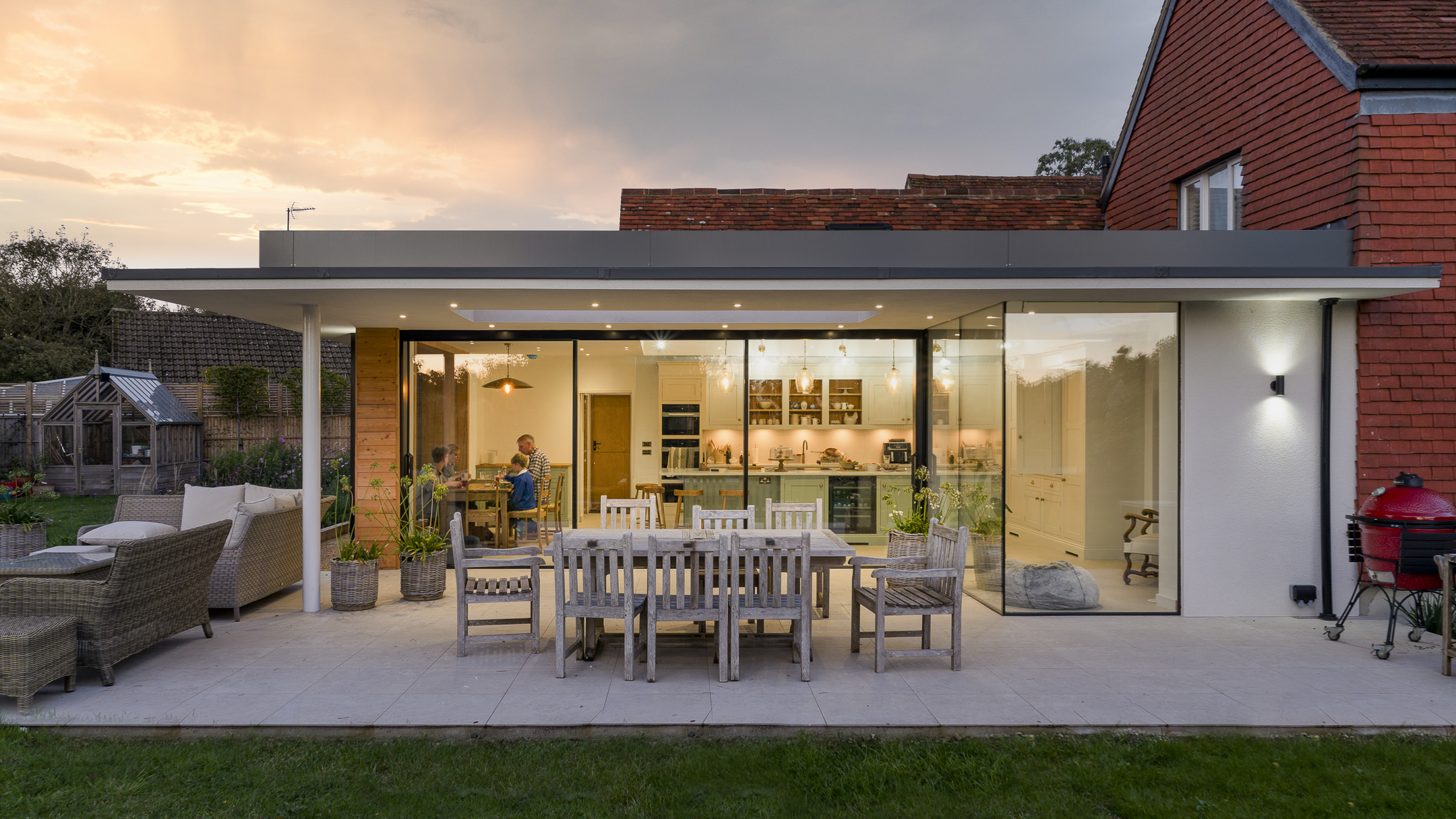Renovating your home is an exciting journey, whether you are planning a light-touch refresh, a full extension, or a major transformation of an older property. One of the biggest questions homeowners face early on is: when should you involve an architect in the process?
This guide explores:
- The role of an architect in a home renovation
- How architects and builders fit together
- The smart sequence for common UK home projects
- Costs and how to budget for professional input
- Common mistakes to avoid
- Whether you need an architect at all
- How to find the right architect for your project
Extension above by Giles, architect in Oxfordshire on Design for Me. See his full profile and shortlist him for your home renovation project here.
Do You Always Need an Architect for a Renovation?
There is no legal requirement in the UK to hire an architect for home projects, even for significant extensions or conversions. However, involving one early is often well worth it. An architect’s role is not just about aesthetics; it is about making sure your vision is feasible, compliant, and within budget.
If your renovation is as simple as redecorating or updating finishes, you may not need one. But for anything involving structural change, layout reconfiguration, extensions, or planning permission, an architect’s guidance can save time, stress, and money.
The Role of an Architect in Renovation Projects
An architect’s expertise goes far beyond sketching floor plans. Their involvement typically covers:
- Feasibility studies – assessing what is possible within planning and building regulations, as well as your budget.
- Concept design – developing initial ideas into layouts that reflect how you live, use space, and want your home to feel.
- Planning applications – preparing drawings, liaising with local authorities, and maximising the chances of approval.
- Technical drawings – detailed documents required for building control approval and for contractors to quote accurately.
- Tendering and builder selection – helping you get like-for-like quotes and avoiding vague allowances that lead to cost creep.
- Contract administration – overseeing the build, managing disputes, and ensuring the project sticks to budget and quality standards.
In short, architects are risk managers as much as designers. They anticipate problems, coordinate approvals, and help you avoid costly mistakes.
The Role of a Builder
Builders, by contrast, are focused on execution. Their role includes:
- Pricing based on the architect’s drawings and specification.
- Managing the site, labour, and materials.
- Ensuring health and safety compliance.
- Delivering the physical build to an agreed programme.
Builders are essential, but they typically enter the process after the design is fixed. Going to a builder first may give you a rough ballpark, but without drawings, it is impossible for them to provide accurate, comparable quotes.
Who Should You Hire First?
For most renovation projects, the sequence is clear: hire an architect first.
An architect helps you:
- Define your brief and explore design possibilities.
- Understand planning and building regulation requirements.
- Produce detailed drawings so builders can provide accurate, comparable quotes.
- Align your ambitions with your budget before construction starts.
Builders then enter the picture once the design is resolved, approvals are in place, and you are ready to tender.
When to Involve an Architect: The Smart Sequence for Common Projects
1. Extensions (rear, side, or wraparound)
- Architect first: assess feasibility, prepare a planning strategy, and produce concept designs.
- Planning check: confirm if your project falls under permitted development or requires formal approval.
- Technical stage: architect prepares building regulation drawings.
- Builder: tender once the design and approvals are complete.
Do you need planning permission for an extension?
2. Loft Conversions
- Architect first: confirm if there is enough head height, how stairs will work, and what structural changes are required.
- Planning: many lofts fall under permitted development, but not all.
- Building regs: architect prepares technical drawings.
- Builder: tender with clear drawings in hand.
3. Internal Reconfiguration (e.g., kitchen knock-through)
- Architect first: especially if structural walls are involved. They will confirm fire safety and escape routes too.
- Planning: not always required, but building regulations almost always apply.
- Builder: price from detailed drawings to avoid surprises.
Open plan and building regulations
4. Buying a House with Renovation in Mind
- Survey first: arrange a building survey with a chartered surveyor.
- Architect: involve them once the survey is complete, to assess feasibility and design potential.
- Optional early step: bring an architect to a viewing for a second opinion.
Do I need an architect before buying a house?
Costs: Architect Fees and Build Budgets
Many homeowners worry that hiring an architect will blow the budget, but in reality, their involvement often saves money by avoiding redesigns, change orders, and disputes.
- Architect fees:
- Percentage of build cost (typically 8 to 15%).
- Fixed fee for smaller projects.
- Hourly rate for advice or pre-purchase consultations.
- Build costs vary by scope, specification, and location. Early cost checkpoints at concept and technical stages help keep the design aligned with your budget.
How much does a house extension cost?
Planning and Building Regulations: Where an Architect Fits
- Planning strategy: architects advise on whether your project qualifies as permitted development, or if you will need planning permission. They also anticipate conservation area or listed building restrictions.
- Building regulations: architects prepare the technical drawings and coordinate with consultants such as structural engineers.
- Party wall matters: separate legal process, but your architect can flag when it applies.
Why planning applications get refused
Common Mistakes to Avoid
- Speaking to builders before you have drawings, which results in vague estimates and surprises later.
- Skipping early planning checks, which leads to costly redesigns.
- Not tendering competitively. Without coordinated information, quotes cannot be compared fairly.
- Assuming permitted development applies. Rules are detailed and nuanced.
- Underestimating timescales. Approvals and surveys can add months.
Do You Always Need an Architect? Alternatives to Consider
You may decide not to hire an architect if:
- Your builder offers design and build services, although it is still wise to get independent advice first.
- You use an architectural technician or technologist for technical drawings only.
- You are only updating interiors, where an interior designer may be more appropriate.
How to Find the Right Architect
Finding an architect who understands your style, budget, and project type is crucial. Look for:
- Experience in similar residential projects.
- Positive client reviews and portfolios.
- Clear explanation of fees and services.
- Someone you feel comfortable working with over many months.
Find an architect in your area
Final Thoughts: When to Involve an Architect
Involving an architect early in your renovation project is almost always the smartest choice. They provide the roadmap, helping you avoid costly detours, secure approvals, and get accurate build quotes.
Whether you are extending your kitchen, converting your loft, or buying a fixer-upper, the right architect ensures your project is not just buildable, but beautifully suited to your lifestyle.



